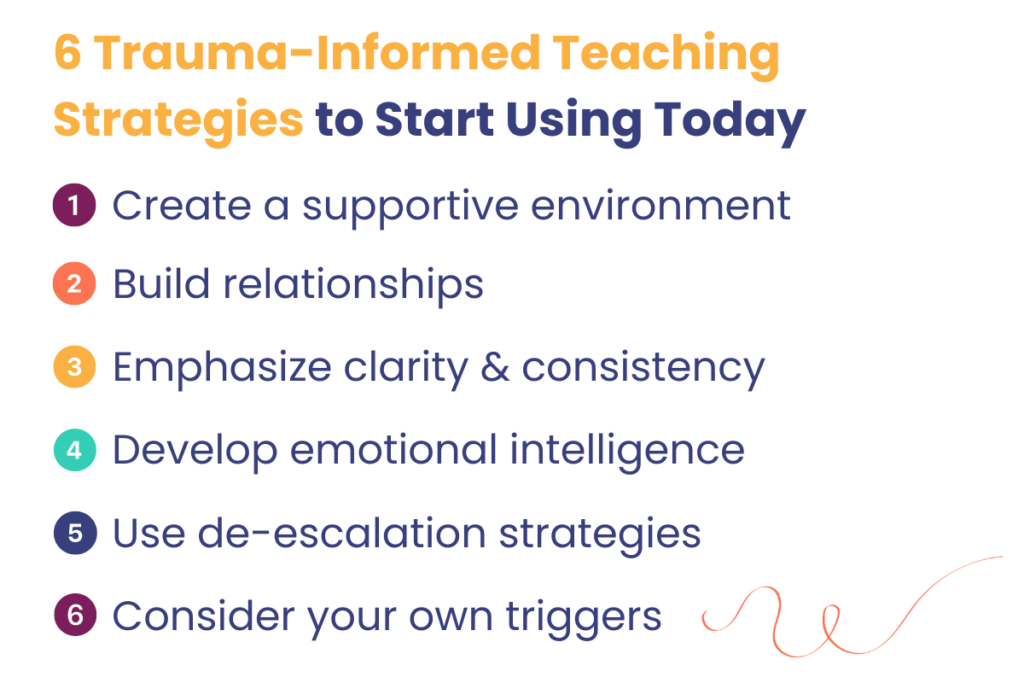It’s not always obvious when a student has experienced trauma, but it can show up in subtle ways—such as difficulty concentrating, withdrawal from peers, emotional dysregulation, or ongoing behavioral challenges.
In fact, research shows that the majority of students—at least 60%—have experienced adverse childhood experiences (ACEs) and chronic stress that affect their performance at school.
On any given day, more than half your class may be experiencing symptoms of trauma. Despite this, nearly half of Pennsylvania educators reported feeling unprepared to recognize these symptoms in students, and almost 80% felt unequipped to teach strategies for managing stress and trauma.
So how can you adapt your teaching practice to support students effectively?
That’s where trauma-informed teaching comes in. In this post, we’ll explore the principles and benefits of trauma-informed teaching and share actionable strategies you can use to create a more supportive classroom environment.
What Is Trauma-Informed Teaching?
We define trauma as “any event that overwhelms our capacity to cope and respond”. Trauma that remains trapped and unresolved can lead to dysregulation at a physiological, emotional, cognitive, or behavioral level.
Trauma-informed education recognizes the impact trauma can have on a student’s ability to learn and behave in the classroom. It involves understanding, acknowledging, and addressing its effects on students, while creating a safe, supportive, and nurturing environment that promotes healing and learning.
Breathe For Change defines trauma-informed education as a way to “build self-regulation by connecting students to inner resources so that they can better tolerate their discomfort, attune to their complexity of experience, and uncouple their emotions from their reactions.” This requires knowing and applying the teaching strategies, practices, and techniques that support a safe and nurturing learning environment.
What Are the 6 Principles of Trauma-Informed Education?
Trauma-informed education is rooted in six key principles that guide educators in creating a safe and supportive learning environment.
These principles help teachers create an inclusive atmosphere where all students can thrive, regardless of their past experiences or current challenges.
Let’s take a closer look at each one:

1. Safety
When students feel safe, they are more likely to engage in learning and take academic risks, which is why creating a sense of physical, emotional, and psychological safety is the foundation of trauma-informed education.
What does this look like in practice? Establishing predictable routines, maintaining a calm classroom atmosphere, and ensuring that students feel secure and supported at all times.
2. Trustworthiness & Transparency
Trauma can undermine a student’s trust in adults, making it essential for trauma-informed teaching to prioritize relationship-building.
One of the most effective ways to establish trust is through transparency—this means clear communication, setting expectations, and consistently following through on your commitments.
By providing consistency, you help students understand what to expect, which reassures them that they are in a stable, reliable environment.
3. Peer Support
When students feel connected to one another, it creates a sense of community and belonging that has been proven to boost their well-being and academic success.
In fact, research has shown that higher levels of peer acceptance are associated with higher self-worth and lower levels of anxiety, loneliness, and depression, which have a direct impact on academic achievement.
You can encourage peer support by creating opportunities for collaboration, group activities, and peer mentoring.
4. Collaboration & Mutuality
Unlike the traditional education practices of the past, which emphasized student obedience, trauma-informed education encourages collaboration between teachers and students.
When you work alongside students in developing classroom norms, rules, and learning goals, you empower them to take ownership of their learning and contribute to a mutually respectful environment.
5. Empowerment, Voice, & Choice
Giving students a voice and choice in their learning process—such as offering options for assignments, incorporating student feedback into lessons, and encouraging students to express their opinions—promotes autonomy and helps them feel heard and valued.
This builds their confidence as learners while strengthening their critical thinking and decision-making—skills that set them up for success in all areas of life.
6. Cultural Responsiveness and Inclusion
Students from diverse cultural backgrounds bring different perspectives and experiences into the classroom. Trauma-informed teaching acknowledges and celebrates these differences, avoids making assumptions, and adapts teaching strategies to be culturally responsive and inclusive. This helps create an environment where all students feel accepted.
What Are the Benefits of Trauma-Informed Teaching?
Trauma-informed teaching not only supports students who have experienced trauma but also creates a positive, inclusive classroom environment where all students can thrive. Here are the core benefits of adopting trauma-informed practices in your teaching approach:
1. Better Student Engagement and Academic Success
While the effects of trauma may impact a student’s ability to focus and engage in learning activities, a trauma-informed approach can boost their ability to concentrate, participate, and retain information.
Incorporating social-emotional learning (SEL) practices—such as mindfulness, self-regulation techniques, and positive relationship-building—has been shown to improve academic outcomes and decrease disruptive behaviors.
2. Improved Emotional Regulation and Behavior
When students experience trauma, they often exhibit behaviors such as hyperactivity, aggression, or withdrawal, which are sometimes misinterpreted as defiance or lack of interest.
Trauma-informed teaching gives you strategies to view these behaviors through a compassionate lens, understanding them as potential responses to trauma rather than intentional disruptions.
In one elementary school that implemented a trauma-informed approach, suspensions decreased from an average of 445 per year to just 19 in the first year. The school also passed state exams for the first time and saw dramatic increases in teacher retention.
3. Increased Feelings of Safety and Trust
One of the main goals of trauma-informed teaching is to create a classroom environment that feels emotionally and physically safe for all students. This means maintaining clear routines, being transparent about expectations, and building consistent, trusting relationships with students. When students feel safe, they are more willing to take academic risks, share their thoughts and experiences, and engage meaningfully in their learning.
How Do I Incorporate Trauma-Informed Teaching into My Practice?
Integrating trauma-informed practices into your teaching approach requires intentionality and a focus on creating a supportive, structured environment that nurtures students’ well-being. Here are a few ideas to help you bring these principles to life in your classroom:

1. Create a Supportive Environment
Help students feel safe, respected, and valued by creating a warm and welcoming atmosphere. One way to do this is by personalizing your classroom with student input—such as allowing them to help choose classroom decorations or creating a “classroom agreement” together. Letting students have a say in their surroundings makes them feel more comfortable and invested in the space.
You could also try starting the day with a “morning check-in” where students share how they’re feeling helps build trust and shows them that their emotional well-being matters. Simple activities like choosing an emoji from a feelings chart or giving a thumbs up or down can set the tone for open communication and help you gauge where your students are emotionally.
Similarly, incorporating breathing exercises or mindfulness moments before transitioning into a new lesson can help students center themselves and release any tension they may be holding. Something as simple as taking three deep breaths together can work wonders to create a calm, focused atmosphere where students feel more present and engaged.
2. Build Relationships
Strong, trusting relationships are the cornerstone of trauma-informed teaching, so take the time to learn about your students’ interests, hobbies, and personal strengths. For example, if you know a student loves drawing, give them opportunities to express their understanding of a topic through art.
Celebrate small victories and consistently show up for your students by acknowledging their efforts, offering personalized encouragement, or simply offering a listening ear during lunch breaks. The more students feel connected to you, the safer they’ll feel in the classroom.
3. Emphasize Clarity and Consistency
Uncertainty and unpredictability can be sources of stress for students who have experienced trauma, so establishing clear routines and communicating any changes ahead of time can put them at ease.
For example, use visual schedules and post the day’s agenda where students can see it. If a schedule change is unavoidable, give students a heads-up, and let them know what to expect next. This consistency helps reduce anxiety and allows students to focus more on their learning.
4. Develop Emotional Intelligence
Encourage your students to recognize and express their emotions by integrating social-emotional learning and mindfulness activities into your daily routine.
For instance, you could start the day with a short mindfulness exercise, such as deep breathing or guided meditation, to help students center themselves and tune in to their thoughts and feelings. Or you could use activities like journaling or group discussions to allow students to explore and share their feelings in a supportive environment.
5. Use De-escalation Strategies
When conflicts arise, avoid power struggles by giving students choices and space to cool down. For example, instead of saying, “Stop talking right now,” offer, “Would you like to take a quick break or stay here and talk it out?”
Giving students choice supports a sense of control and helps them feel respected which can quickly de-escalate tense situations.
Another approach is using non-confrontational language and a calm tone of voice, which signals that you are there to support, not to punish.
6. Consider Your Own Triggers
Be mindful of your own emotional responses when dealing with challenging situations, practice empathy, and remember not to take things personally. If a student’s behavior triggers frustration or irritation, take a few deep breaths, or step away for a moment if possible.
Reflect on your own emotions and ask yourself: “What does this behavior say about the student’s needs right now?” This practice helps you stay grounded and better able to support your students without becoming overwhelmed or reactive.
Create a Supportive Learning Environment with Trauma-Informed Teaching
The first step toward incorporating trauma-informed teaching into your practice is having the right tools and support. Breathe For Change offers a range of resources to guide you, from our free Trauma-Informed Strategies Toolkit to our comprehensive Master’s of Education program.
Ready to transform your classroom? Download the toolkit and start implementing trauma-informed teaching strategies today!





